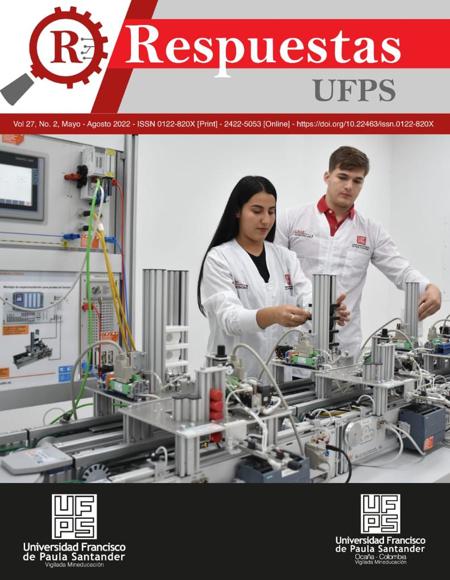Design and implementation of a launching mechanism for CANSAT devices
Diseño e implementación de un mecanismo de lanzamiento para dispositivos CANSAT
Main Article Content
Our Cyborg CEA team, formed by students from College Empresarial Los Andes, has proposed for the CANSAT Colombia 2021 innovation challenge to develop a launching device that allows CANSATs to overcome the conventional launching height, which for students of school categories is usually from the highest floor of a building. For this reason and taking advantage of the local availability of gunpowder along with the miniaturization of electronic components and modular design we propose to develop and launch a bullet type satellite.
Downloads
Publication Facts
Reviewer profiles N/A
Author statements
Indexed in
- Academic society
- Universidad Francisco de Paula Santander
- Publisher
- Universidad Francisco de Paula Santander
Article Details
J. Meneses Suta et al., “MISIONES TIPO CANSAT: UNA ESTRATEGIA PARA EL FOMENTO DE LAS TECNOLOGÍAS AEROESPACIALES EN LOS ESTUDIANTES DE INGENIERÍA DE LA EMAVI-FAC,” Cartagena, 2021.
M. Arruabarrena. et al ., “Minisatélite cansat aplicado al aprendizaje basado en problemas en diversos contextos educativos,” [Online]. Disponible en: https://www.researchgate.net/profile/Marcos-Requena-Arellano/publication/344359099_MINISATELITE_CANSAT_APLICADO_AL_APRENDIZAJE_BASADO_EN_PROBLEMAS_EN_DIVERSOS_CONTEXTOS_EDUCATIVOS/links/5f6be03c458515b7cf496bd6/MINISATELITE-CANSAT-APLICADO-AL-APRENDIZAJE-
J. Contente., and C. Galvão, “STEM Education and Problem-Solving in Space Science: A Case Study with CanSat,” Education Sciences, vol. 12, no, 4, pp. 200-251. 2022.
J. J. Núñez Quispe, “Design and Simulation of a Rover CanSat Non-pneumatic Wheel: Preliminary Study for a Certain Test Obstacle Path,” 2020. [Online]. Disponible en: https://ieeexplore.ieee.org/abstract/document/9522526/figures#figures
M. Hasan., I. I. Rahman., M. Hossam., E. Haider., and A. A. M. Shah Sadman. "Design of CanSat for Environmental Monitoring and Object Detection,” International Conference on Electrical Engineering, vol. 4, no. 2, pp. 1-6. 2021.
J. A. Ames Lizarbe, “INCAnSat: CanSat for Education and Environmental Monitoring,” Aerospace and Electronic Systems Magazine, vol. 36, no. 12, pp. 43-50. 2021, doi: 10.1109/MAES.2021.3120236.
B. G.Chae, and H. U. Oh, “Desarrollo de la plataforma Power Plant Trio CanSat impulsada por sistemas de recolección de energía solar, eólica y piezoeléctrica,” Ciencia espacial, vol. 22, no. 4, pp. 1464–1480. 20211. https://doi.org/10.1007/s42405-021-00382-y
L. Anchino., A. Torti., M. Miretti., E. Bernardi., G. Peretti., and R. Podadera, “Desarrollo de un Dispositivo CANSAT para Fomentar el acceso a las tecnologías espaciales,” 2019. [Online]. Disponible en: http://sedici.unlp.edu.ar/bitstream/handle/10915/77328/Documento_completo.pdf-PDFA.pdf?sequence=1&isAllowed=y
B. B. Reyes, “Curiosidad - CANSAT lata-satélite,” 2016. [Online]. Disponible en: http://eprints.uanl.mx/8145/1/Documento14.pdf.
AESS Colombia, “Cansat Latinoamérica”, 2021. [En línea]. Available: https://aesscolombia.blogspot.com/p/cansat-2021.html.
“C. CEA. Github – SatlieteDelEnd,” 2021. [Online]. Disponible en: https://github.com/NicolasDiaz69/SateliteDelEnd.
A. Gómez Roa., M. L. Paz González., A. Calvillo Téllez., J. A. Paz González., O. A. Morales Contreras, and J. C. Núñez Pérez, “Análisis dinámico estructural de satélite educativo CanSat,” Computación y Sistemas, vol. 22, no. 2, pp. 451-461, 2018. https://doi.org/10.13053/cys-22-2-2942
P. M. González, “Proyecto cansat: cargas útiles estudiantiles en coheteria modelo y experimental,”. [Online]. Disponible en: http://astroeduc.com.ar/cargas%20utiles.pdf
A. S. Pineida Escorza, WLanzador de red para captura de cóndores andinos,” (Tesis de grado). Universidad Técnica del Norte. Quito, Ecuador, 2021.
N. D. Ismail., M. N. Hambali., S. J. Anak Eric., and N. E. Zahirul Islam, “Development of Nano-Satellite, AEROSAT for Space Education,” Multidisciplinary Applied Research and Innovation, vol. 2, no. 3, pp. 294–298. 2021. https://penerbit.uthm.edu.my/periodicals/index.php/mari/article/view/5132
K. Youngjun. et al ., “Development of CanSat System With 3D Rendering and Real-time Object Detection Functions,” Journal of the Korean Society for Aeronautical & Space Sciences, vol. 49, no. 2, pp. 671-680. 2021.
J. J. Mejía González., S. A. Zapata Gil., S. León., N. Buriticá Isaza., D. A. González Jaramillo., and J. M. Zamora Vélez, “Development of a CANSAT Prototype for the Detection of Vegetation Areas in Precision Agriculture through Aerial Imaging,” Ciencia y Poder Aéreo, vol. 16, no. 2, pp. 1-18. 2021.
M. Akiyama., and T. Saito, “Research on a method to guide CanSat to a goal at a distance of 0 m using deep learning,” Instituto de Ingenieros en Electrónica, Información y Comunicación, vol. 104, no. 7, pp. 540-551. 2021.
D. C. Marubin., and Y. Sim Sy, “Development of Appropriate Power Distribution Design for Can-Sized Satellite (CANSAT),” Journal of Advanced Industrial Technology and Application, vol. 2 no. 2, pp. 1–10. 2021.
J. D. Osorio Henao., J. J. Botina Monsalve., D. A. Díaz Álvarez., M. Galeano Ruiz., J. P. Higuita Echavarría., and L. F. Burbano Mosquera, “Picosatélite diseñado para medir concentración de gases de efecto invernadero y registrar imágenes en vuelo,” Ciencia y Poder Aéreo, vol. 16, no. 1, pp. 1-12. 2021.








